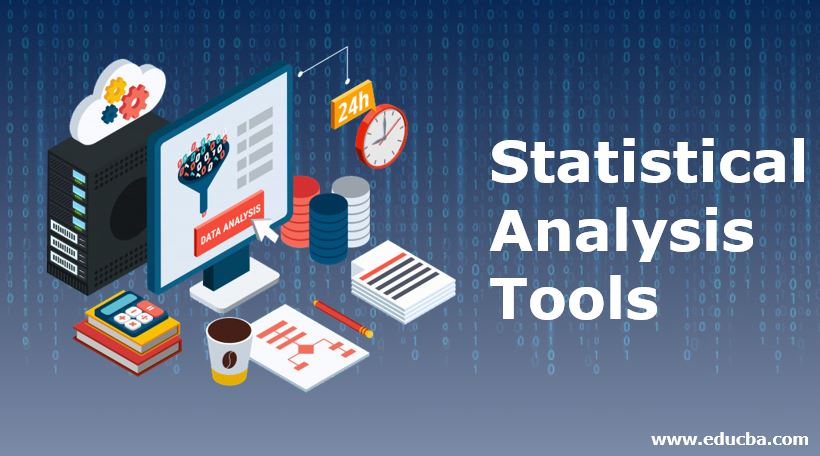Updated June 19, 2023
Introduction to Statistical Analysis Tools
The mathematical computations used for data analysis are called statistics. Description, summarization, and data comparison can be done using statistical analysis tools. The statistical data can be analyzed using various tools. Statistical data analysis ranges from simple computations to analysis at an advanced level. The computation of basic analysis is simple, whereas the computation of advanced analysis needs a good understanding of statistics at an advanced level and a sense of computer software. Software designed for statistical analysis makes understanding what to do with the data and how to perform results interpretation as easy as possible.
Types of Statistical Analysis Tools
There are several tools available to carry out statistical analysis of data. They are:
1. Statistical Package for the social sciences (SPSS)
The most widely used software package for statistics within human behavior research is the Statistical Package for the social sciences. A statistical package for the social sciences can compile descriptive statistics, parametric and non-parametric analysis, and Graphical User Interface (GUI) to depict the results graphically. The analysis can be automated by creating scripts, and this option is included in the statistical package for the social sciences.
2. R Foundation for Statistical Computing
The software package for statistical analysis used in human behavior research and other fields and is free is R. The different aspects of data processing can be simplified by a great range of applications for which the toolboxes are available. R requires coding to a certain degree though R is a powerful software. R also has a steep learning curve. A community is actively engaged to build and improve R and the associated plugins.
3. Matlab (The MathWorks)
Engineers and scientists widely use an analytical platform and programming language called Matlab. The learning curve is steep, and the code must be created eventually. Research questions can be answered using toolboxes that are available in large numbers. For example, EEG data can be analyzed using the EEGLAB tool. Learning Matlab is difficult for beginners, but there is huge flexibility in terms of what you want to do if the coding can be done.
4. Microsoft Excel
Microsoft Excel is not an advanced solution for statistical analysis, but Microsoft Excel offers a wide variety of tools for data visualization and simple statistics. It has become a valuable tool for those who want to see the basics of their data by generating summary metrics, customizable graphics, and figures. Many individuals and companies own and know how to use Excel, making it easier for anyone to start learning statistics.
5. Statistical Analysis Software (SAS)
Advanced analysis can be performed using the graphical user interface or creating scripts on a statistical analysis platform called Statistical Analysis Software (SAS). It is an advanced solution used in healthcare, business, human behavior research, etc. Users can perform advanced analysis and generate publication-worthy graphs and charts using GraphPad Prism, even though coding may pose difficulties for those unfamiliar with this approach.
6. GraphPad Prism
The statistics related to biology make use of software called GraphPad Prism. GraphPad Prism can apply in various fields beyond just biology due to its versatile statistical capabilities. Users can automate analysis and perform complex statistical calculations using scripting options like the Statistical Package for the Social Sciences. However, the Graphical User Interface serves as the primary interface for most tasks.
7. Minitab
Data analysis can be carried out using both basic and advanced statistical tools offered by a software called Minitab. Graphical User Interface and scripted commands execute commands like in GraphPad Prism, making it available to beginners and those looking to conduct a complex analysis.
8. Stat Graphics
Stat graphics has powerful functionality designed for professional users and businesses across the globe. Even non-statisticians can experience the advantages of business analytics by using stat graphics. Users can run statistical analysis, build models, and design experiments intuitively.
9. XLSTAT
Using various tools provided by XLSTAT can enhance the analytical capabilities of Excel. This makes it ideal for statistics and data analysis requirements.
10. Qlik Sense
Business intelligence (BI) and a visual analytics platform called Qlik Sense support analytical use cases.
11. Origin Pro
Origin Pro is the name of the software that provides a user-friendly, point-and-click interface for data visualization, analysis, and exploration. You can optimize batch operations by implementing workflows.
12. Wolfram Mathematica
The tools are provided for image processing, geometry, visualization, machine learning, data mining, etc., by a technical computing system called Wolfram Mathematica.
13. Phocas Software
Phocas is a cloud-based SaaS company specializing in data analytics for the manufacturing, distribution, and retail industries.
14. Birst
Birst is the name of the leader in next-generation business intelligence and analytics. It provides automation, optimization, and agility throughout the business intelligence process.
15. SAS Business Intelligence
SAS Business intelligence software is a business intelligence software to prepare data, discover valuable insights and share it in a governed, self-served manner.
16. Sigma Plot
The businesses create and manage two and three dimensions visualizations of data using scientific graphing and data analysis solutions called Sigma Plot.
17. Matomo Analytics
Matomo Analytics is an open-source web analytics platform. Over 1.4 million websites in one hundred and ninety countries use it. Piwik, formerly known as Matomo Analytics, underwent a name change.
Conclusion
Several software tools are available, each offering different functionality to the user. Our functionality will depend on several factors, like research questions, statistics knowledge, and coding experience. The quality of the study’s execution directly links to the quality of the data collected, as we have reached the pinnacle of data analysis, as with all research.
Recommended Articles
This has been a guide to Statistical Analysis Tools. Here we discuss the basic concept with 17 different types of Statistical Analysis Tools in detail. You may also have a look at the following articles to learn more –




